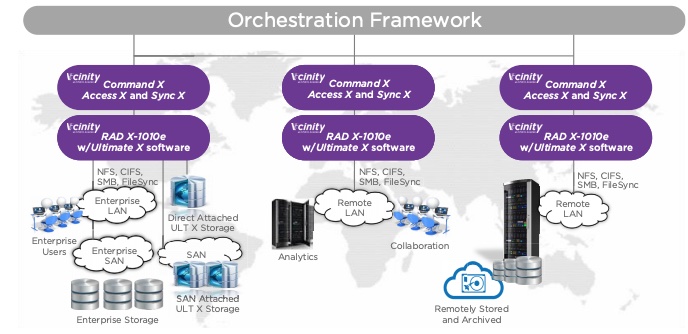Vcinity, a San Jose networking startup, has transferred 1PB of file data across a 4,350 mile, 100 Gbit/s WAN, with 70 ms latency in 23 hours and 16 minutes.
It says it can use up to 97 per cent of the available network bandwidth in the link.
The company’s Ultimate X (ULT X) products use a fabric extension technology, and support InfiniBand and also RDMA over Converged Ethernet (RoCE).
Vcinity says it can make a remote filer seem as if it were local. Chief Technology Officer Russel Davis said: “Our technology has shattered the mould of data-access – we extend RDMA over global distances, so users can remotely access, manage and manipulate large datasets.”

This PB-transferred-in-under-24-hours claim rang a distant memory bell. Surely … yes, Bay Microsystems did just that in May 2018, moving a petabyte of data across a 2,800 mile network link in a little over 23 hours. It said it took the distance out of data at the time.
How do these two companies and their technologies relate to one another?
Bay Microsystems
Bay Microsystems was founded in 1998 and went through six funding rounds, taking in $34.4m publicly and possibly more privately. Its CEO from November 2015 to October 2018 was Henry Carr and its COO and EVP for emerging solutions was Russ Davis from January 2014 to October 2018.
Vcinity came out of stealth mode in October 2018 and its CEO is Henry Carr. Russ Davis is also its CTO and COO. The SVP for Engineering is Bob Smedley and he was SVP Engineering at Bay Microsystems too. The CFO is Mike McDonald and his LinkedIn entry says he has been in that position since 2004, which is nonsense as the firm was only founded in 2018.
Sure enough, Crunchbase lists him as Bay Microsystems CFO.
Vcinity says it acquired Bay Microsystems assets in July 2018. There was no fanfare and no reason was given for Bay Microsystems going out of business.
Steve Wallo, VP for Sales Engineering at Vcinity, held the same role at Bay Microsystems. Mark Rodriguez, VP Product Management at Vcinity, was in the same position at Bay Microsystems.
There are no recorded funding rounds for Vcinity, but the board includes James Hunt, a professional investor, and Scott Macomber, a private investor.
Vcinity is Bay Microsystems reborn
It’s obvious that Vcinity is actually Bay Microsystems reborn, probably re-financed, and the technology is re-worked Bay Microsystems technology.
Vcinity sells its technology as RAD X-1010e and RAD X-1100 PCIe cards and ULT X software running in off-the-shelf Linux servers or in virtual machines. This presents a NAS (NFS and SMB) interface to accessing application servers.

The products can be used to move data fast across long distances for migration purposes, or to carry out real-time actions on far-away files.
Get an Ultimate X product brief here. Vicinity only sells through channel partners and has them in the USA (12), Europe (3) and Asia (2). Find out more from them.







